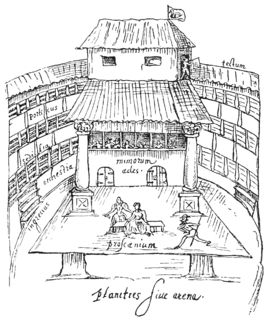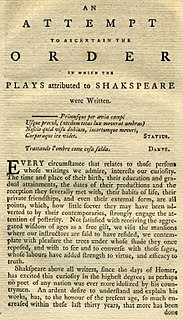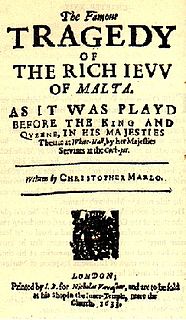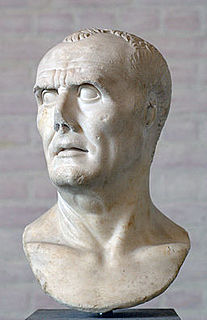
English Renaissance theatre—also known as Renaissance English theatre and Elizabethan theatre—refers to the theatre of England between 1562 and 1642.
Thomas Kyd was an English playwright, the author of The Spanish Tragedy, and one of the most important figures in the development of Elizabethan drama.

In the First Folio, the plays of William Shakespeare were grouped into three categories: comedies, histories, and tragedies. The histories—along with those of contemporary Renaissance playwrights—help define the genre of history plays. The Shakespearean histories are biographies of English kings of the previous four centuries and include the outliers King John, Edward III and Henry VIII as well as a continuous sequence of eight plays covering the Wars of the Roses. These last are considered to have been composed in two cycles. The so-called first tetralogy, apparently written in the early 1590s, deals with the later part of the struggle and includes Henry VI, parts one, two & three and Richard III. The second tetralogy, finished in 1599 and including Richard II, Henry IV, Part 1, Henry IV, Part 2 and Henry V, is frequently called the Henriad after its protagonist Prince Hal, the future Henry V.
The Ur-Hamlet is a play by an unknown author, thought to be either Thomas Kyd or William Shakespeare. No copy of the play, dated by scholars to the second half of 1587, survives today. The play is known to have been staged in London, more specifically at The Burbages Shoreditch Playhouse as recalled by Elizabethan author Thomas Lodge. The play is known to have a character named Hamlet; the only other known character from the play is a ghost who cries, "Hamlet, revenge!"

King Leir is an anonymous Elizabethan play about the life of the ancient Brythonic king Leir of Britain. It was published in 1605 but was entered into the Stationers' Register on 15 May 1594. The play has attracted critical attention principally for its relationship with King Lear, Shakespeare's version of the same story.

This article presents a possible chronological listing of the composition of the plays of William Shakespeare.

Locrine is an Elizabethan play depicting the legendary Trojan founders of the nation of England and of Troynovant (London). The play presents a cluster of complex and unresolved problems for scholars of English Renaissance theatre.

The Jew of Malta is a play by Christopher Marlowe, written in 1589 or 1590. The plot primarily revolves around a Maltese Jewish merchant named Barabas. The original story combines religious conflict, intrigue, and revenge, set against a backdrop of the struggle for supremacy between Spain and the Ottoman Empire in the Mediterranean that takes place on the island of Malta. There has been extensive debate about the play's portrayal of Jews and how Elizabethan audiences would have viewed it.

Tamburlaine the Great is a play in two parts by Christopher Marlowe. It is loosely based on the life of the Central Asian emperor, Timur. Written in 1587 or 1588, the play is a milestone in Elizabethan public drama; it marks a turning away from the clumsy language and loose plotting of the earlier Tudor dramatists, and a new interest in fresh and vivid language, memorable action, and intellectual complexity. Along with Thomas Kyd's The Spanish Tragedy, it may be considered the first popular success of London's public stage.

The plays written by English poet, playwright, and actor William Shakespeare have the reputation of being among the greatest in the English language and in Western literature. Traditionally, the plays are divided into the genres of tragedy, history, and comedy; they have been translated into every major living language, in addition to being continually performed all around the world.
The Admiral's Men was a playing company or troupe of actors in the Elizabethan and Stuart eras. It is generally considered the second most important acting troupe of English Renaissance theatre.
The Battle of Alcazar is a play attributed to George Peele, perhaps written no later than late 1591 if the play "Muly Molucco" mentioned in Henslowe's diary is this play, and published anonymously in 1594, that tells the story of the battle of Alcácer Quibir in 1578.

A bad quarto, in Shakespearean scholarship, is a quarto-sized publication of one of Shakespeare's plays that is considered spurious, pirated from a theatre without permission by someone in the audience writing it down as it was spoken or written down later by an actor or group of actors, which, according to a theory, has been termed "memorial reconstruction". Since the quarto derives from performance and lacks a direct link to the author's original manuscript, the text would be expected to contain corruptions, abridgements and paraphrasings.
Cuthbert Burby was a London bookseller and publisher of the Elizabethan and early Jacobean eras. He is known for publishing a series of significant volumes of English Renaissance drama, including works by William Shakespeare, Robert Greene, John Lyly, and Thomas Nashe.
Edward Allde or Alde was an English printer in London during the Elizabethan and Jacobean eras. He was responsible for a number of significant texts in English Renaissance drama, including some of the early editions of plays by William Shakespeare.
The Blind Beggar of Alexandria is an Elizabethan era stage play, a comedy written by George Chapman. It was the first of Chapman's plays to be produced on the stage; its success inaugurated his career as a dramatist.

The term memorial reconstruction refers to the hypothesis that the scripts of some 17th century plays were written down from memory by actors who had played parts in them, and that those transcriptions were published. The theory is suggested as an explanation for the so-called "bad quarto" versions of plays, in which the texts differ dramatically from later published versions, or appear to be corrupted or confused.

The University Wits is a phrase used to name a group of late 16th-century English playwrights and pamphleteers who were educated at the universities and who became popular secular writers. Prominent members of this group were Christopher Marlowe, Robert Greene, and Thomas Nashe from Cambridge, and John Lyly, Thomas Lodge, and George Peele from Oxford. Thomas Kyd is also sometimes included in the group, though he is not believed to have studied at university.

The True Tragedy of Richard III is an anonymous Elizabethan history play on the subject of Richard III of England. It has attracted the attention of scholars of English Renaissance drama principally for the question of its relationship with Shakespeare's Richard III.














